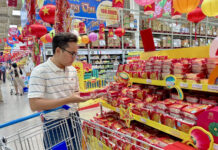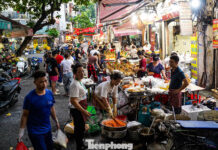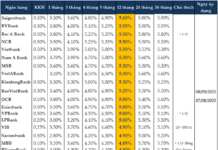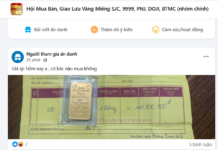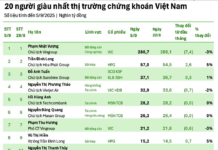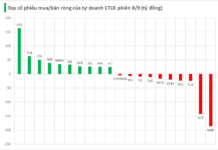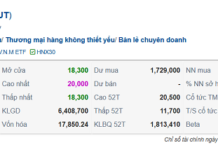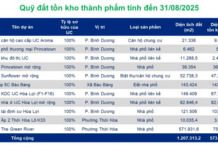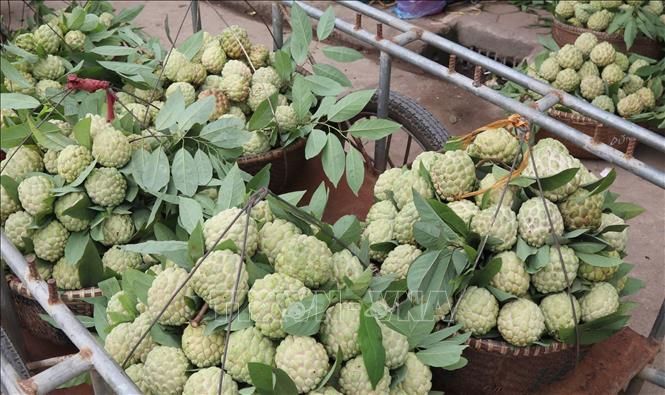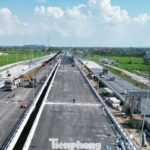
Na Chi Lăng is renowned for its thin light green skin, white-pink eye, thick flesh, few seeds, and distinctively sweet and delicious taste.
Lân Giao Na Market, located in Lân Giao village (Chi Lăng commune, Chi Lăng district) and nestled along the old National Highway 1A, is likened to a “port” for na fruit. Even before the break of dawn, when the light is still dim and objects are barely visible, the market is already bustling with people. Here, half-ton baskets of na are skillfully lowered from the mountains using pulleys, navigating through small valleys filled with sharp cat’s ear rocks.
Below, locals quickly secure the baskets of na onto motorcycles or stack them onto pushcarts for transportation to consumption centers. Even without dedicated transportation for the na, there are always traders and merchants ready to purchase the fruit directly from the farmers. The trading activities are swift, and thus, the Lân Giao market is only bustling with na sales from 5 AM to 9 AM.
On her first visit to Chi Lăng to indulge in the sweet taste of the mountain na, Ms. Nguyễn Thị Chanh, a tourist from Lai Châu province, excitedly shared her surprise at the unique method of transporting the na from the mountains while still maintaining the quality and appearance of the fruit. The na is carefully arranged in baskets and crates, ensuring aesthetics and preventing damage. Tasting freshly picked na right from the tree is a special experience. She believes that offering tourists a chance to pick na directly from the orchards would be a fantastic activity…
Mr. Vi Văn Viễn, from Quán Thanh village, Chi Lăng commune, Chi Lăng district, Lạng Sơn province, shared his insights: “Caring for na trees is arduous labor. To ensure the fruits ripen at the right time, farmers have to climb the mountains to prune branches, weed, and till the soil starting from the Lunar New Year. In the past, many people were unaware of Chi Lăng na, and the market was limited. Farmers had to harvest and sell their produce at the market themselves. Now, however, the brand has gained recognition, and many na orchards are contracted by traders and merchants in advance, relieving farmers of the worry about product distribution.”
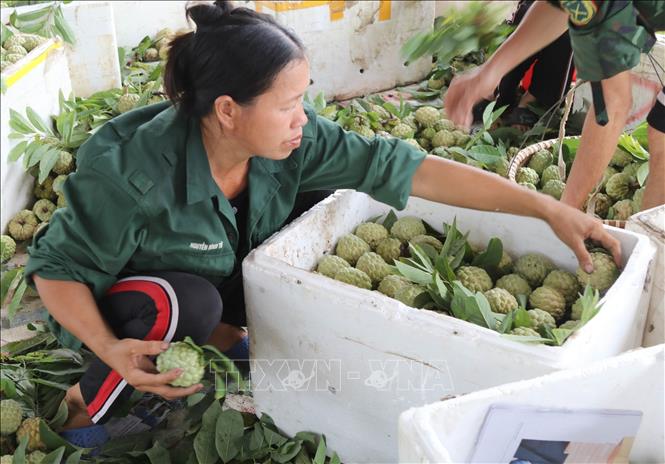
Locals in Chi Lăng town, Chi Lăng district, Lạng Sơn province, pack na for transportation to consuming provinces. Photo: Nguyễn Quang Duy/VNA
According to assessments by agricultural households, favorable weather conditions have greatly benefited the growth and development of na trees, resulting in larger and more aesthetically pleasing fruits, thereby stabilizing prices. At the beginning of the harvest season, traders purchase na at prices ranging from 35,000 to 50,000 VND per kg, depending on the type. Retail prices for the firm Chi Lăng na with attractive appearances range from 55,000 to 60,000 VND per kg, and can even reach 80,000 VND per kg.
Ms. Hoàng Minh Phương, a well-known na trader in Chi Lăng commune for over a decade, and with extensive experience in na cultivation, shared her expertise: “Na is usually harvested early in the morning when the fruit’s skin transitions from green to yellowish-green, with rounded shapes, prominent eyes, and white crevices. The freshly picked na is then placed in cool, shaded areas. To ensure the best quality for consumers, proper packaging techniques must be employed, with the na stems facing downward, and gentle handling to avoid bruising and loss of bloom. During transportation, extra care is taken to avoid strong impacts that may damage the fruit, and proper boxing methods are utilized.”
To support the economic interests of farmers, the local authorities have been actively promoting commercial facilitation and seeking consumption linkages since the beginning of the harvest season. There has been a focus on developing concentrated production areas, implementing product traceability, and ensuring food hygiene and safety.
According to the Department of Agriculture and Rural Development of Chi Lăng district, the total area under na cultivation in the region exceeds 2,500 hectares, of which approximately 740 hectares are grown according to GlobalGAP and VietGAP standards. Additionally, four na products from Chi Lăng have attained the OCOP (One Commune, One Product) 4-star certification.
For the 2024 harvest season, Chi Lăng district is estimated to yield approximately 24,000 tons of na, including off-season production. Chi Lăng na is predominantly cultivated on steep and treacherous mountain slopes, where soil erosion, leaching, and rapid nutrient depletion are common issues. Therefore, farmers and local authorities have been diligent in adopting synchronized technical measures to increase fruit yield, quality, and appearance.
Mr. Lương Thành Chung, Head of the Department of Agriculture and Rural Development of Chi Lăng district, Lạng Sơn province, shared that his department, in collaboration with the Center for Agricultural Services and relevant communes and towns, has been actively promoting scientific and technical advancements to enhance productivity and yield. These include pollination, branch pruning, fertilizer application, the use of organic and microbial fertilizers, and the implementation of yellow fly traps across the entire growing area. Additionally, Chi Lăng district has been committed to building the brand image of Chi Lăng na through commercial fairs, agricultural product introductions, brand promotion, and the expansion of consumption channels via online agricultural product booths on social media and e-commerce platforms.
Chi Lăng is the district with the largest na cultivation area in Lạng Sơn province, with most of the orchards located in eight mountainous communes and towns, including Mai Sao, Chi Lăng, Vạn Linh, Thượng Cường, Y Tịch, Hòa Bình, Đồng Mỏ, and Chi Lăng. Chi Lăng na is renowned for its large, evenly sized fruits with smooth skin, white-pink eyes, thick flesh, sweet taste, and few seeds. Thanks to na cultivation, many households, especially those of ethnic minorities, have achieved annual incomes ranging from several tens to several hundred million VND. This has significantly contributed to local socio-economic development, promoted agricultural commercialization, and fostered new rural construction with the distinctive characteristics of Chi Lăng.


